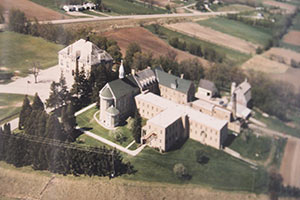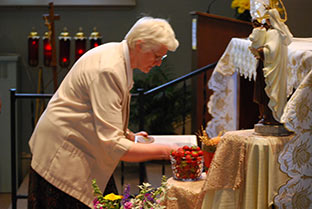MOUNT CALVARY – “This is Holy ground.”
Simple, but powerful words rooted in faith guide 93-year-old School Sister of Notre Dame Lucy Marie Ruebenzer as she hopes and prays Our Lady of Mount Carmel convent remains somehow in service to God when it closes this summer after 160 years.
 An aerial view of the Our Lady of Mount Carmel Convent campus in Mount Calvary. (Photos courtesy of School Sisters of Notre Dame)Leaders of the Central Pacific Province of the School Sisters of Notre Dame decided last October to permanently shut the doors of the convent in this rural crossroads community in eastern Fond du Lac County.
An aerial view of the Our Lady of Mount Carmel Convent campus in Mount Calvary. (Photos courtesy of School Sisters of Notre Dame)Leaders of the Central Pacific Province of the School Sisters of Notre Dame decided last October to permanently shut the doors of the convent in this rural crossroads community in eastern Fond du Lac County.
The decision followed a recommendation in January, 2011 by the former Milwaukee Province of the School Sisters of Notre Dame to close the convent. That recommendation was based on a 20-year study of the convent’s facilities.
A decrease in the number of sisters living at Mount Carmel, along with its aging buildings, most in need of major repairs and upgrades, forced the decision, said Sr. Maxine Bauer, local leader of the SSND.
“Our boiler system has been running overtime on our prayers,” Sr. Maxine said. “ God is good. We’ve made it through many cold winters.”
In a letter notifying benefactors of the decision to close Mount Carmel, Sr. Maxine said plans are to sell the convent’s buildings and its 37 acres located in the center of Mount Calvary, near St. Lawrence Seminary High School.
The sisters and their convent played crucial roles at least twice in the history of St. Lawrence Seminary and the Capuchin Franciscans who founded the school.
‘Hub of educational opportunity’
Established in 1852 as a hub of educational opportunity for Mount Calvary and the surrounding Fond du Lac County area known locally as the “Holy Land,” the convent changed its mission in recent decades from one of being a school with as many as 65 sisters in residence to a home for retired Notre Dame sisters and for sisters in poor health.
Some of the 22 Mount Carmel sisters have relocated or will relocate to Sheboygan, Green Bay, or Notre Dame of Elm Grove, a long-term care facility offering resources and nursing facilities to meet their needs.
Sr. Lucy came to Mount Carmel 43 years ago, in 1969, and served as the convent’s official driver. Mother Caroline Friess, center, led the School Sisters of Notre Dame in North America for 42 years, from 1850 until her death at age 68 in 1892. The four sisters surrounding her held positions of authority in the motherhouse and schools. (Submitted photo courtesy the School Sisters of Notre Dame)
Mother Caroline Friess, center, led the School Sisters of Notre Dame in North America for 42 years, from 1850 until her death at age 68 in 1892. The four sisters surrounding her held positions of authority in the motherhouse and schools. (Submitted photo courtesy the School Sisters of Notre Dame)
“They called me ‘Sister Go-Go.’ We had a brown, Ford station wagon. I would drive the sisters to appointments in Fond du Lac and to airports in Chicago, Milwaukee and Green Bay,” she said.
Hidden in a century-old red barn on the convent site is a six-passenger white golf cart used by Sr. Lucy to give visitors rides on the convent grounds when age prevented her from driving on area highways.
“When visitors came I always gave them a nice ride the first time around the property. The second time I would go real fast. I’ll miss my golf cart. Sr. Maxine said we should put our names on whatever we want to take with us to Elm Grove. I’m putting my name on the golf cart,” Sr. Lucy said.
The State of Wisconsin was just four years old when Mother Caroline Friess founded Mount Carmel in July of 1852. The Mount Calvary facility was the first branch house of the Milwaukee motherhouse of School Sisters of Notre Dame, established two years earlier.
A local Catholic priest, Fr. Casper Rehrl, purchased 40 additional acres and built two log cabins, one for the school and one for the teacher. It was Fr. Rehrl who introduced Mother Caroline, during the feast of Corpus Christi, to the school and future convent. The meeting followed a journey for Mother Caroline from Milwaukee to Sheboygan by boat and by buggy to Greenbush on the way to Mount Calvary.
During the buggy trip to Mount Calvary (then known as Calvary), Mother Caroline was forced to flee the buggy several miles from her destination.
The quilt hanging in the convent depicts Mother Caroline, in a white habit, suitcase in hand, jumping from the buggy.
“The driver of the buggy made improper advances to her so she jumped out with her bags and walked to the nearest log cabin, whose occupants gave her a ride the next day to Mount Calvary,” said Sr. Maxine.
Serving the poor
Life was tough for the early sisters/teachers as they reached out to the poverty-stricken families of the surrounding community, said Sr. Maxine.
“Students were supposed to pay 12 cents a month for board. Half of them couldn’t afford it,” Sr. Maxine said. “The sisters usually lived on black coffee and bread. Sometimes they would even ask the students for part of their lunch. There just wasn’t anything.”
The sisters’ long partnership with the Capuchins (and the future St. Lawrence Seminary) began after 1856 when two Swiss priests, Fr. Gregory Haas and Fr. John Frey, came to Mount Calvary intent on establishing the first permanent friary of the Capuchin Order in the United States. As the priests struggled financially to build a friary, the sisters offered to temporarily turn their convent over to them.
The Capuchins started the Convent Latin School in 1860 and in 1862 founded St. Lawrence Seminary.
Meanwhile, the sisters built a brick building to replace the wooden boarding house and slept in it one night before a fire on Christmas Day night in 1868 burned down the friary, Sr. Maxine said.
“The fire hit during a typhoid epidemic among the students at St. Lawrence. They didn’t have any place to take the sick students so the sisters told the Capuchins to bring the students to Mount Carmel,” Sr. Maxine said.
Partners with the community
The sisters’ partnership with the Mount Calvary community was just as strong as the one it had with the Capuchins, said Esther Boehnlein, a Mount Calvary native who attended Holy Cross School. Sr. Maxine Bauer, local leader and administrator of Our Lady of Mount Carmel Convent in Mount Calvary, presents a history of the convent and two ornaments containing images of Holy Cross School, 1908-2009, and Mount Carmel Convent, 1852-2012, during the entrance procession for the June 10 liturgy celebrating the sisters’ 160 years at the convent. (Submitted photo courtesy the School Sisters of Notre Dame)
Sr. Maxine Bauer, local leader and administrator of Our Lady of Mount Carmel Convent in Mount Calvary, presents a history of the convent and two ornaments containing images of Holy Cross School, 1908-2009, and Mount Carmel Convent, 1852-2012, during the entrance procession for the June 10 liturgy celebrating the sisters’ 160 years at the convent. (Submitted photo courtesy the School Sisters of Notre Dame)
“The sisters always seemed to have a smile on their face. When you met them on the street they were always willing to talk to you,” Boehnlein said. “ When I went to school they were always so kind. You had to have breakfast, lunch and dinner. The sisters always made sure you got fed.”
Boehnlein said her husband and other community members would go up the hill to help the sisters butcher chickens once a year.
“That was a big deal. We used to butcher 50 chickens a day,” said Sr. Joan Emily Kaul. “We used to supply all the eggs for the motherhouse.”
Sr. Lucy said the convent, up until a couple years ago, also raised cattle, a practice going back to the founding days when Mother Petra Forrenia Kletzlen, a novice when she came to Mount Calvary in 1854, decided the Mount Carmel mission needed cows for milk.
“The motherhouse said no. Mother Petra bought a cow anyway. When she sent in the bill she put down ‘roast beef’ and got away with it,” Sr. Lucy said.
Mother Petra served the convent for 68 years and is buried in a small cemetery on the convent grounds.
Sr. Joan Emily, 86, said she hopes the historic cemetery is saved, but feels there is no use to fighting to save the entire convent complex.
“I can hardly think about it being closed without getting choked up. But I know this is the way it has to be. We can’t keep going with the sisters the way they are. That would be dumb,” said Sr. Joan Emily, who served as the Holy Cross School building administrator before it was torn down.
“We don’t have the people to put into the place anymore. Common sense says you can’t keep up something when you don’t have the resources. Even so, leaving here is hard because it’s so beautiful,” she said.
Common sense doesn’t dull emotions for the sisters and Mt. Calvary residents.
“I remember as a child picking asparagus along the road and taking it up to the sisters, who would buy it and give you nickels,” said Mt. Calvary resident Shirley Horn. “They would be delighted to get it. Whenever you did something for them they would reward you, either with a holy object, candy or something like that. The community always respects the sisters. The closing is sad. I hope they preserve the buildings.”
An auction is scheduled for July 14 to dispose of anything remaining at the convent.
‘Sad day’
“I might go to the auction out of curiosity, but it will be a very sad day,” Horn said.
Sr. Cynthia Bormann, 81, said she isn’t looking forwarding to moving to Elm Grove.
“I’ll miss Mt. Carmel. Elm Grove is an institution. This is not an institution. It’s home. You can walk into the kitchen and get anything you want. We’re not going to find that at Elm Grove,” Sr. Cynthia said.
Sr. Regina Meyer uses a motorized wheelchair to get around the convent complex, but is reluctant to leave hilly surroundings and solitude of Mt. Carmel.
“There are more people living at Elm Grove and I don’t like crowds. It’s so peaceful and quiet here,” said Sr. Regina, who taught math and English in Catholic schools in Wauwatosa, South Milwaukee and West Bend before retiring to Mount Carmel.
Sr. Maxine said the remaining sisters recently spent time reflecting on the past and future of Mount Carmel.
“During Mass we went over, room-by-room, recalling stories about things important to each person we did in that room. We also talked about special things we did like dressing up in costumes for Halloween,” Sr. Maxine said.
A ritual closing Mass was celebrated Sunday, June 10.
Sr. Maxine, who is charged with organizing the sisters’ move to other facilities, said she hasn’t had time to mourn the convent’s closing.
“I tell everyone I’m going to cry when I’m gone from here. I don’t have time to cry now,” she said. “I do feel bad. Our presence has been here for 160 years. Our presence is not going to be here anymore. And there’s nothing we can do about it.”
